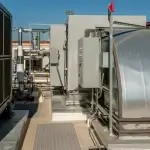When those crisp, cool autumn breezes start blowing in, it’s easy to ignore your HVAC system. After all, fall is usually pretty moderate temperature-wise. But before you get distracted by pumpkin spice everything, make sure your HVAC is prepped for the cold weather ahead. Performing key maintenance checks and tasks now saves you headaches (and money!) through the winter.
As the owner of a small retail chain, I’ve learned this lesson the hard way. One year we put off our fall maintenance, only to have three furnaces quit working right as a cold snap hit in December. Our service tech said the issues could’ve been caught earlier. We ended up having to close several stores over the holidays to get the repairs done. Don’t make the same mistake we did! September is the best time to schedule maintenance?
Why Fall Maintenance is Crucial
Your HVAC works harder in the winter—it’s just a fact of life. Once temperatures drop, your system has to labor way more to heat your space. This extra burden exposes any lurking issues with your HVAC. Think of your unit like a marathon runner—you wouldn’t send them on a 26 mile trek without proper training and care first!
Colder Weather Strains the System
All the components in your HVAC go through wear and tear. The cold just accelerates this process. Problems with refrigerant levels, duct integrity, air filters and more will crop up when your system is taxed by winter demands. Getting ahead of these issues now avoids headaches down the road.
Lingering Debris Causes Problems
Over the spring and summer, dust and pollen build up in your HVAC system. This debris gets stuck in components like coils and blower motors. When you kick your system into high gear for winter, that accumulation causes strain. Cleaning it out now improves efficiency.
Refrigerant Leaks and Other Issues Go Unnoticed
When it’s mild out, issues with refrigerant levels, duct leaks, blower motors and more may not be obvious. You aren’t likely to notice a little loss of efficiency. But when high heating demands hit, these small problems become big problems. Getting a system tune-up now identifies and corrects these hidden issues.
Increased Heating Demands Overwork Faulty Components
Faulty capacitors, compressors, igniters and heat exchangers lurking in your system may seem fine…until peak winter usage reveals them. If you don’t detect and replace these components now, they’ll fail when taxed by winter heating needs.
Create a Maintenance Schedule
You wouldn’t just run a marathon without training, right? Treat your HVAC system the same way. Create a structured maintenance plan and stick to it.
Inspect Equipment on a Set Schedule
Check components like air filters, coils, blower motors, belts, etc. once a month or per your manufacturer’s advice. Examine for damage, leaks, blockages and more. Consistent inspections catch problems before they spiral.
Schedule a Tune-Up
Have an HVAC technician do a thorough tune-up in early fall. They’ll methodically inspect everything, replace worn parts, check refrigerant levels, and more. Think of it as a physical exam for your HVAC!
Document Maintenance
Track all maintenance completed, whether by your staff or vendors. This lets you spot trends and see where frequent issues arise. Maintaining documentation also comes in handy if you need to dispute a warranty claim!
Key Maintenance Tips
Not sure what tasks your maintenance plan should include? Here are some of the most critical to-dos:
Refrigerant Levels
Check that refrigerant levels are adequate. Top off any low refrigerant to ensure your AC can still cool efficiently next summer. Low refrigerant causes all sorts of issues.
Ductwork
Inspect ducts for leaks, holes, and loose connections. Air leaks reduce efficiency and performance. Seal any gaps or damages immediately.
Coils and Drain Pans
Clean your coils and drain pans thoroughly before winter. Built-up dust, dirt and debris impedes proper operation. Use a coil cleaner and sprayer to remove accumulations.
Air Filters
Replace air filters per manufacturer guidelines, usually every 1-3 months. Dirty filters overwork your blower motor and strain the system.
Moving Parts
Lubricate blower motors, bearings, fans and other moving components. This prevents winter wear and tear.
Defrost Settings
For heat pumps, verify defrost settings are correct. This optimizes the defrost cycle, preventing ice buildup when temperatures fluctuate.
Heating Operation
Run several heating cycles to confirm furnaces, heat pumps, etc. are heating properly. Better to uncover issues now than in January!
Insulation
Check any ductwork or pipes running through unheated spaces. Re-insulate sections as needed to maximize efficiency.
Don’t Pay the Price for Delayed Maintenance
Being proactive with fall HVAC maintenance saves money in repairs, energy bills, and operational disruptions during winter. Just a few hours of diligent maintenance now prevents weeks of headache later! Give your HVAC the time and care it deserves before old man winter comes knocking. You’ll breeze right through the cold months worry-free!





